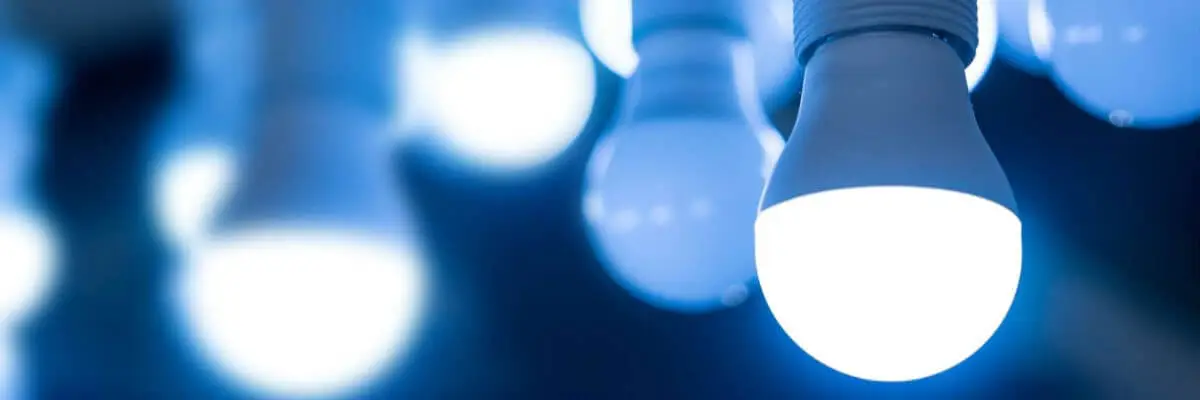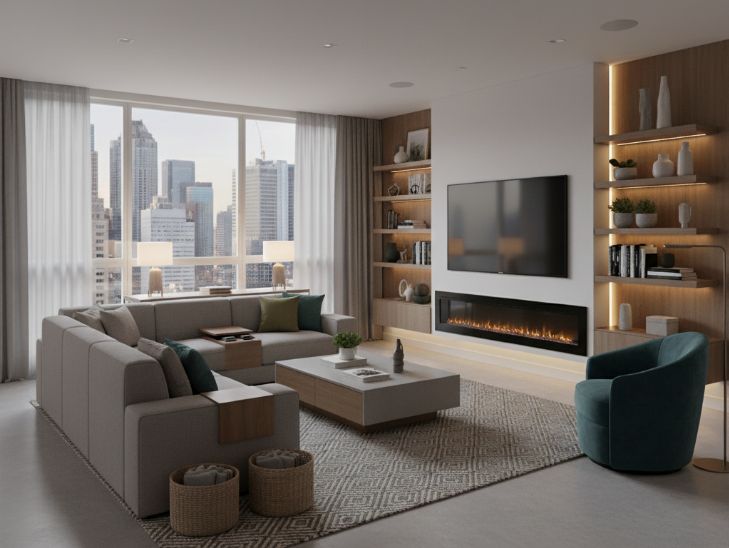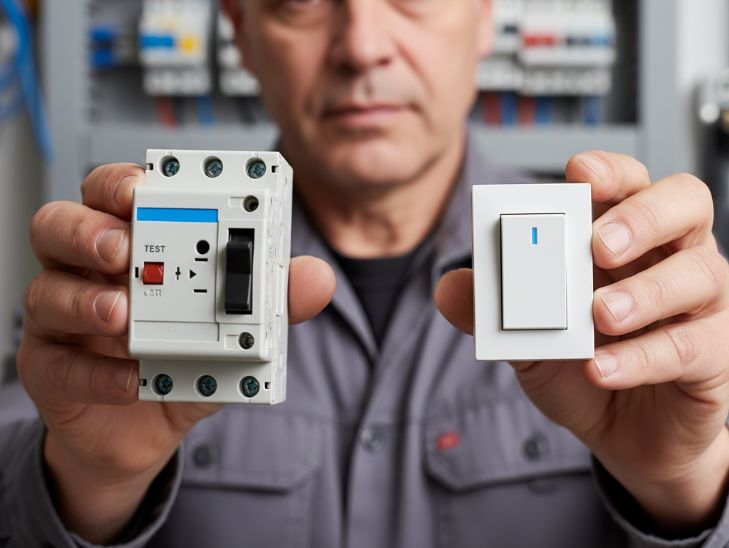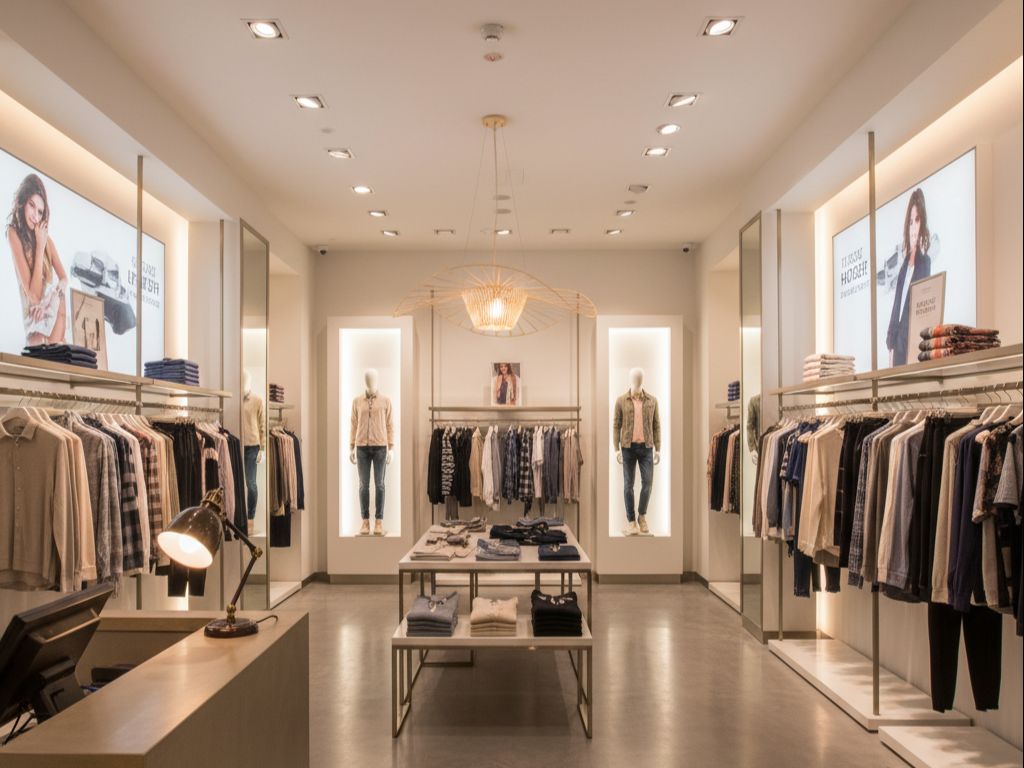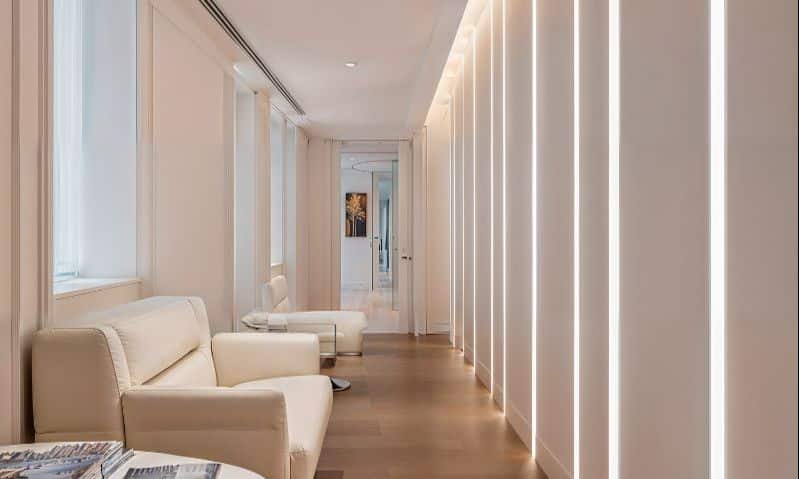Selecting the right bulb requires consideration of: socket type, brightness, light hue (warm, neutral or cool) or color rendering index (CRI). Be sure to opt for bulbs with quality certifications, compatible with dimmers if you need them, and avoid common mistakes such as assuming that more watts equals more brightness. The right choice ensures energy savings, quality lighting and longer life.
Let’s look in detail at the types of bulbs we can find and how to choose the best one for each use case.
- What types of bulbs are there and how do they differ?
- Comparison chart: consumption, lifetime and efficiency
- Key factors to consider when choosing a light bulb
- Advantages of LED bulbs over the rest
- Conclusion: what type of light bulb is best for your needs.
What types of bulbs are there and how do they differ?
Choosing the right bulb may seem simple, but with the variety of options available on the market, it is essential to know the characteristics of each type in order to make an informed decision.
Incandescent bulbs
Incandescent bulbs were long the standard choice in household lighting. These bulbs work by heating a tungsten filament until it emits light. Although they provide a warm, pleasant light, they have several disadvantages.
- Energy efficiency: They are highly inefficient, converting only about 10% of the energy into light, while the rest is lost as heat.
- Useful life: They have a short useful life, generally between 750 and 1,000 hours.
- Environmental impact: Due to their low efficiency and short lifetime, they contribute to higher resource consumption and waste generation.
Although they have been widely used, incandescent bulbs have been phased out in many countries due to their energy inefficiency.
Halogen bulbs
Halogen bulbs were introduced as an improved version of incandescent bulbs. They use a halogen gas that allows the filament to operate at higher temperatures, resulting in brighter light and higher efficiency.
- Energy efficiency: They are approximately 20-30% more efficient than incandescents.
- Lifetime: They have a lifetime of between 2,000 and 4,000 hours.
- Light quality: They provide a bright white light, suitable for tasks requiring good visibility.
However, halogen bulbs still generate a significant amount of heat and are being replaced by more efficient options such as LEDs.
Compact fluorescent lamps (CFL)
Compact fluorescent light bulbs, or CFLs, represented a significant improvement in terms of energy efficiency over incandescent and halogen bulbs.
- Energy efficiency: They consume 70% to 75% less energy than incandescent bulbs.
- Lifespan: Their lifespan varies between 6,000 and 15,000 hours.
- On time: Some CFLs can take a few seconds to reach maximum brightness.
Despite their advantages, CFLs contain small amounts of mercury, which requires proper handling and disposal to avoid negative environmental impacts.
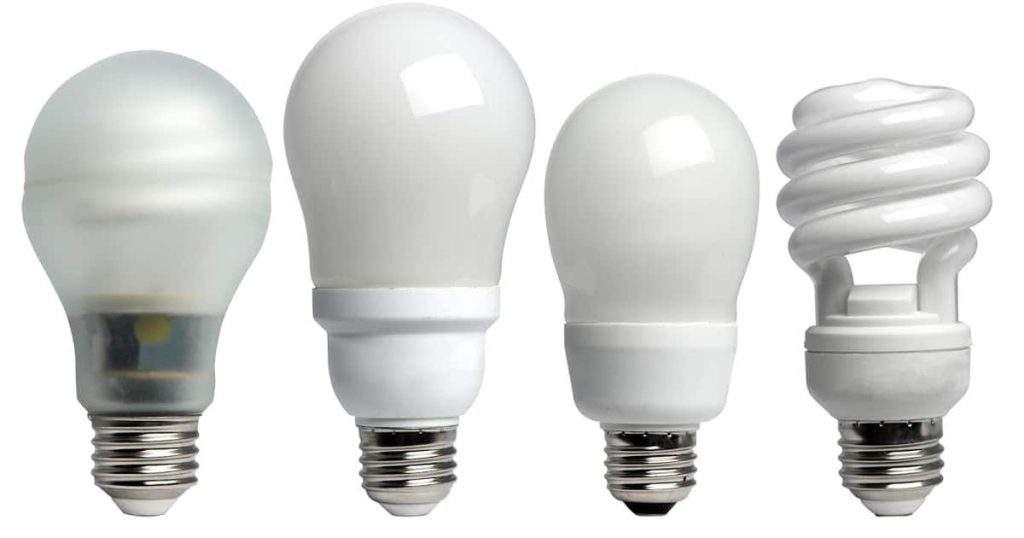
LED bulbs
LED bulbs have become the new standard in today’s lighting due to their efficiency, durability and versatility.
- Energy efficiency: They consume up to 85% less energy than incandescent bulbs.
- Lifetime: They can last between 15,000 and 50,000 hours, depending on quality and use.
- Variety: They are available in a wide range of colors and color temperatures, adapting to all kinds of needs or preferences.
In addition, LED bulbs do not contain mercury and reach their maximum brightness instantly, making them a safe and convenient option for the home.
Types of LED bulbs for home
Within LED bulbs, there are different types designed for various household applications:
- Standard LED: Ideal for ceiling and table lamps.
- Dimmable LED: They allow adjusting the light intensity according to the needs.
- Smart LEDs: Can be controlled by mobile apps or voice assistants, offering functions such as color changing and scheduling.
- Filament LEDs: Combine the vintage aesthetics of incandescent bulbs with the efficiency of LED technology.
When choosing an LED bulb for the home, it is important to consider the socket type, light output and color temperature to ensure proper and efficient lighting.
Comparison chart: consumption, lifetime and efficiency
An effective way to visualize the differences between bulb types is by means of a comparison chart. This makes it easier to make decisions when choosing the most suitable option according to your needs and priorities.
| Bulb Type | Consumption (W) | Life (Hours) | Energy Efficiency | Instant On | Contains Mercury |
|---|---|---|---|---|---|
| Incandescent | 40 – 100 | 750 – 1.000 | Very Low | Yes | No |
| Halogen | 30 – 80 | 2.000 – 4.000 | Low | Yes | No |
| CFL | 8 – 30 | 6.000 – 15.000 | Medium-high | No (takes a few seconds) | Yes |
| LED | 4 – 20 | 15.000 – 50.000 | Very high | Yes | No |
As can be seen, LED bulbs are the clear winners in all the key aspects: low consumption, long life, high efficiency and immediate ignition. Incandescent bulbs, on the other hand, lag far behind in every category, which is why they are practically obsolete.
Key factors to consider when choosing a light bulb
Choosing the right bulb goes far beyond looking at price or wattage. There are several technical and practical factors to consider to ensure that the lighting fits your space and needs.
Here are the key aspects to consider when choosing a quality bulb.
Socket and compatibility
The first step is to identify the type of bulb socket you need. The most common are:
- E27: Coarse thread, common in ceiling and floor lamps.
- E14: Fine thread, common in table lamps and sconces.
- GU10: Two thick pins, common in recessed spotlights.
- MR16: Two fine pins, used in accent lighting.
Selecting a bulb with the correct socket ensures a smooth installation. To see all available connection types you can consult our bulb socket types guide.
Lumens and light output
It is a common mistake to associate power (wattage) with brightness. In reality, brightness is measured in lumens. For example, a 100W incandescent bulb produces approximately 1,000 lumens, while a 12W LED bulb can provide similar brightness with significantly less energy consumption. Therefore, it is critical to check lumens to ensure that you are getting the desired illumination.
- 250-450 lumens: Equivalent to a 25W incandescent bulb. Ideal for ambient lighting.
- 800-1100 lumens: Similar to a 60-75 W incandescent. Perfect for general room lighting.
- 1600 lumens or more: Recommended for areas requiring intense light such as kitchens or work areas.
If you want to illuminate your home well, opt for LED bulbs that provide a high amount of lumens with low power consumption.
Color temperature
The color temperature, measured in kelvin (K), has an important influence on the atmosphere of the room. The main options are:
- Warm Light (2700K-3000K): Ideal for living rooms and bedrooms, creates a cozy atmosphere.
- Neutral Light (4000K-4500K): Recommended for bathrooms and kitchens, offers a clear and natural lighting.
- Cool Light (5000K-6500K): Suitable for work areas or garages, provides a bright and energizing light.

Choosing the right color temperature is essential to adapt the lighting to the activities carried out in each space.
Color Rendering Index (CRI)
The CRI measures the ability of a light source to faithfully reproduce colors. A high CRI (close to 100) indicates high quality color rendering. For home use, a minimum CRI of 80 is recommended to ensure accurate color perception.
Energy consumption and efficiency
Energy efficiency refers to how much electricity a bulb consumes to generate light. LED bulbs are the most efficient, followed by CFLs, halogen and, lastly, incandescent bulbs.
Life and ignition cycles
The lifetime of a bulb directly affects its cost-effectiveness. LEDs not only last much longer, but will withstand thousands of on/off cycles without degrading, making them ideal for places where light is frequently turned on and off (such as hallways or bathrooms).
- LED: Up to 50,000 hours.
- CFL: May degrade if repeatedly turned on and off.
- Halogen/Incandescent: Low tolerance to constant cycling.
Investing in bulbs with high durability ensures fewer replacements and less long-term maintenance.
Dimmer Compatibility
If you plan to use bulbs with dimmers, it is critical to make sure they are compatible. Not all LED bulbs are dimmable and not all dimmers (especially older ones) work well with LEDs. Combining non-compatible items can result in flickering or reduced bulb life.
Certifications and Quality
Opt for bulbs with certifications such as CE and RoHS, which guarantee compliance with European safety, quality and environmental standards. These labels give you the assurance that you are acquiring a reliable product free of hazardous substances.
Advantages of LED bulbs over the rest
If you still have doubts about why you should switch to LED lighting, here are its main advantages over other types:
- Energy saving: Up to 85% less consumption compared to incandescent bulbs.
- Longer life: No need to change bulbs constantly.
- Low environmental impact: They do not contain mercury and reduce the carbon footprint.
- Versatility: Available in multiple shapes, colors and temperatures.
- Smart technology: Some can be controlled with apps or voice commands.
In addition, in our catalog you will find the perfect option for every type of room, from kitchens, bathrooms or living rooms to terraces.
Recommended products
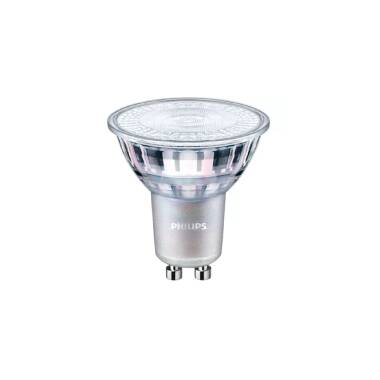
In Stock, delivery in 15-20 days
5.79 £
LED Bulb GU10 PAR16 3.7W 60º Dimmable 365lm PHILIPS Master Value LEDspot MV
View product
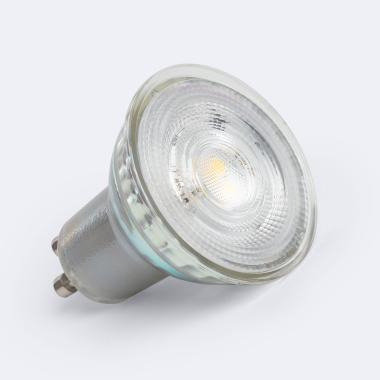
In Stock, delivery in 24/48h
2.1 £
GU10 LED Bulb 7W 30º 700 lm Glass
View product
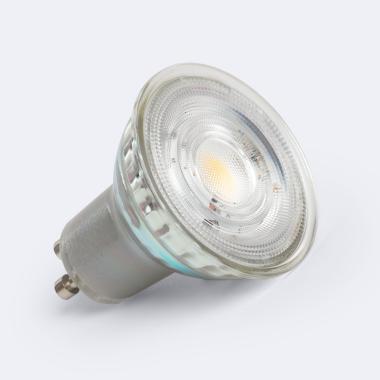
In Stock, delivery in 24/48h
3.29 £
GU10 LED Bulb 10W 60º 1000 lm Glass
View product
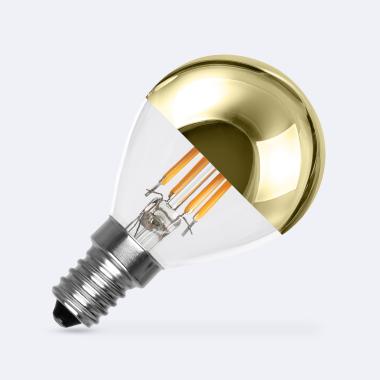
In Stock, delivery in 24/48h
2.21 £
E14 LED Bulb 4W G45 400 lm Gold Reflect
View product
Conclusion: what type of light bulb is best for your needs.
After analyzing the characteristics, advantages and limitations of each type of bulb, it is clear that the ideal bulb choice will depend largely on the specific use you are going to make of it, as well as your priorities in terms of efficiency, budget and aesthetics.
If you are looking for maximum energy savings
Without a doubt, LED bulbs are your best option. Not only do they consume much less energy than any other type of bulb, but they also last significantly longer. This combination translates into considerable financial savings in the long run, even though the initial investment may seem higher. If you’re transitioning to a more efficient home, opt for LED bulbs in every room.
If you want to maintain a classic or retro aesthetic
Filament LED bulbs are ideal for you. They retain the look of traditional incandescent bulbs, but with all the benefits of modern LED technology. They are perfect for decorative lamps, vintage living rooms or any space with a nostalgic feel.
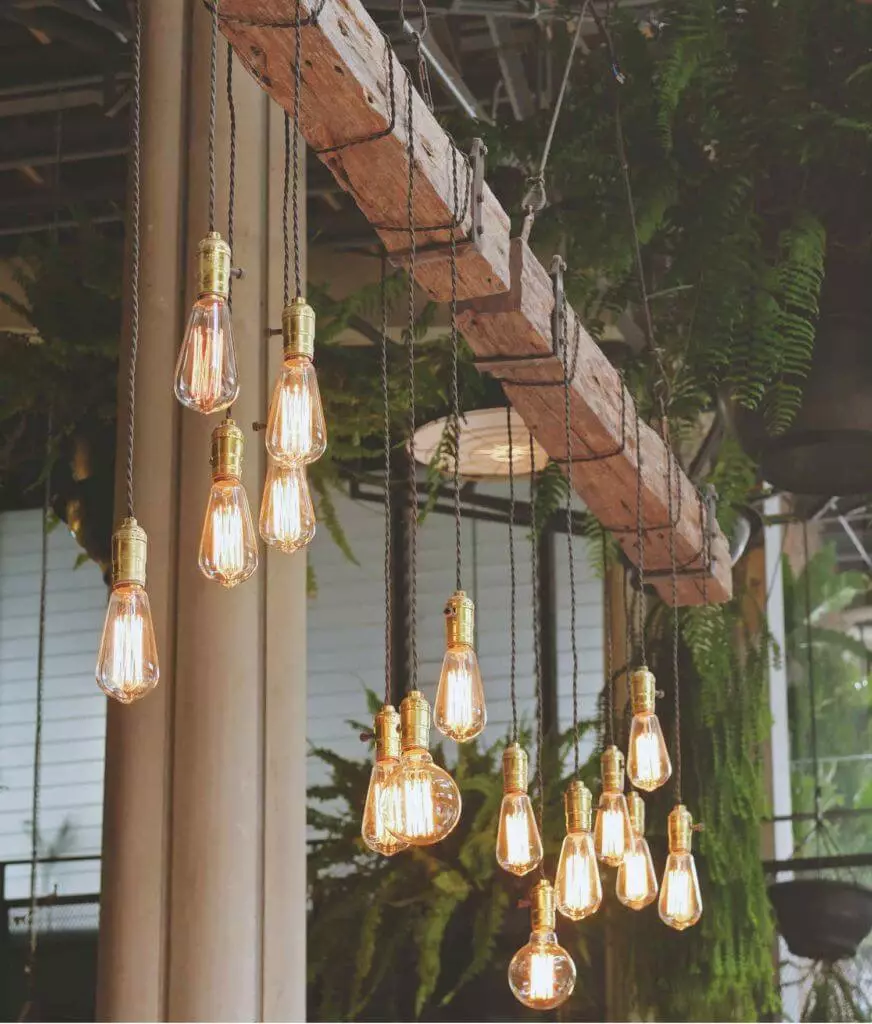
For rooms with occasional use or low budget
A few years ago halogen or CFL bulbs were used as a temporary or low-cost solution. However, with the current prices of LED bulbs it does not make sense to opt for any of these technologically obsolete options.
For spaces where you turn on and off frequently
LED bulbs are winning again. They are resistant to on/off cycling, so they don’t degrade with constant use. This makes them the best choice for bathrooms, hallways, stairways and walkways.
Investing in efficient lighting not only reduces energy consumption, but also reduces environmental impact and saves money in the long run. Choosing your bulbs wisely is a smart decision that turns home lighting into a way to take care of the planet. In addition, the versatility of LEDs improves comfort, since the right light creates more pleasant, functional environments adapted to every need.
You may be interested in

Modern style, elegant and functional
Discover the modern style, its keys and how to apply it to achieve elegant and functional spaces

Types of lighting according to their function
Designing with light means understanding its effect and combining types of lighting to achieve balanced, functional and attractive spaces

WCOB LED technology
WCOB LED lighting with superior efficiency, continuous light and modern design for a professional finish

Grounding: What it is, how it works and why it’s vital to your safety
Discover how grounding protects equipment and people, safely diverting electrical currents to the ground

Vintage lighting: lamps with history and style
Transform your home with vintage style lighting and bring personality and timeless charm to every space

